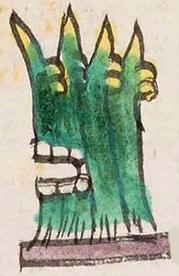Toltitlan (Mdz3v)
This compound glyph for the place name Toltitlan shows a cluster of tules (tollin) colored two tones of green and with yellow flowers standing upright on a thin, gray, rectangular, horizontal base. A full set of white teeth re embedded in the group of tules. They are shown in profile, slightly open, and facing the viewer's left.
Stephanie Wood
Gordon Whittaker suggests that the full set of teeth is more often used when the locative includes the ligature (-ti-), resulting in -titlan. This example supports the case. Advanced searches for glyphs ending in -tlan and ending in -titlan will provide data showing a somewhat mixed result, but there is a tendency toward what Whittaker suggests.
Stephanie Wood
Stephanie Wood
c. 1541, or by 1553 at the latest
Stephanie Wood
tules, dientes, nombres de lugares

tol(lin), tules, https://nahuatl.wired-humanities.org/content/tollin
tlan(tli), tooth/teeth, https://nahuatl.wired-humanities.org/content/tlantli
-tlan (locative suffix), by, near, among, https://nahuatl.wired-humanities.org/content/tlan
Codex Mendoza, folio 3 verso, https://digital.bodleian.ox.ac.uk/objects/2fea788e-2aa2-4f08-b6d9-648c00..., image 17 of 188.
The Bodleian Libraries, University of Oxford, hold the original manuscript, the MS. Arch. Selden. A. 1. This image is published here under the UK Creative Commons, “Attribution-NonCommercial-ShareAlike 3.0 License” (CC-BY-NC-SA 3.0).



